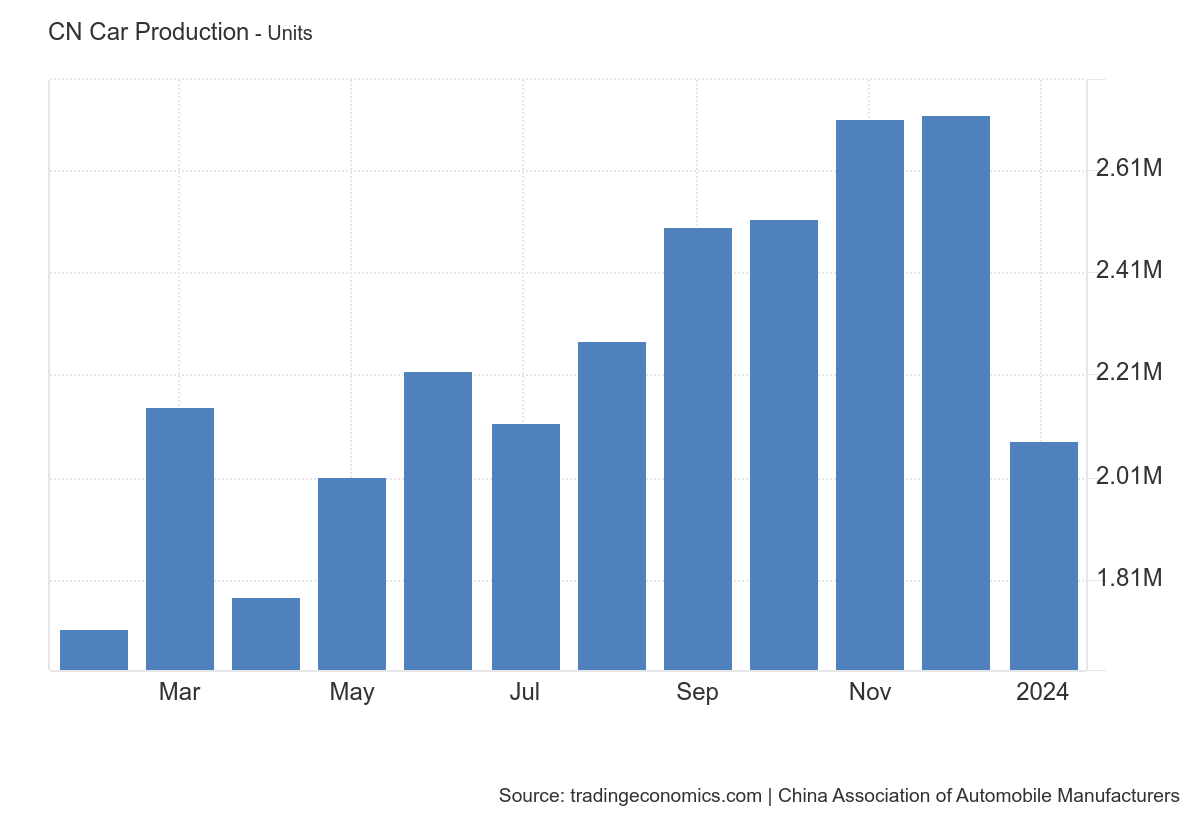Economy and business
Can the Chinese car destabilize the global car market?

China’s car industry has experienced explosive growth in recent years, fueled by a combination of factors like government incentives, rising domestic demand, and a focus on electric vehicles (EVs). While this growth presents an undeniable economic advantage for China, it also raises concerns about potential overproduction and its impact on the global car market.
China’s Car Production Powerhouse
Let’s delve into the data. According to the China Association of Automobile Manufacturers (CAAM), China produced a record 30.16 million vehicles in 2023, surpassing the previous record set in 2017. This translates to roughly a quarter of global car production.

Chinas’s car production Monthly
Electric Vehicle Ambitions
China is also leading the charge in electric vehicle production. In 2022, China produced an estimated 5.5 million electric vehicles, accounting for over half of the global EV market share (source IEA). This rapid growth is driven by government subsidies, tax breaks, and ambitious targets for EV adoption.
Export Surge: A Double-Edged Sword
China’s car exports have also witnessed a significant rise. Data from Trading Economics [source: https://tradingeconomics.com/china/exports-of-motor-vehicles-chassis] suggests exports surged by 58% in 2023, reaching 4.91 million units. While this benefits Chinese manufacturers, it also raises concerns about potential market saturation and competition for established carmakers worldwide.
The Challenge of Overproduction
The sheer volume of car production in China raises concerns about overproduction. An oversupplied market leads to:
- Price Wars: As carmakers compete for a limited pool of buyers, price wars can erupt, leading to thinner profit margins for all players, including Chinese manufacturers.
- Quality Concerns: In a rush to meet production quotas, quality control may deteriorate. This could negatively impact Chinese automakers’ long-term reputation for reliability.
- Environmental Impact: Producing more cars, even electric vehicles, still contributes to resource depletion and energy consumption.
Impact on the Global Market
China’s booming car industry, while impressive, poses potential challenges to the global market.
- Disruption for Established Players: Traditional carmakers in Europe, the US, and Japan may face increased competition from cheaper Chinese imports, especially in developing markets. This can threaten jobs and market share.
- Pressure on Innovation: With Chinese manufacturers focusing on volume, there’s a risk that innovation in areas like autonomous driving and advanced safety features might slow down compared to global rivals.
- Quality Concerns: The need to conquer markets at any cost can lead to the export, in easier and less regulated markets, of products with inferior and inadequate quality characteristics
- Financial instability: when the market is not sufficient, the struggle for market share can lead to the sale of cars with operating incomes that are too low and such that they do not remunerate fixed costs, leading companies to financial crises. This is all the more dangerous when interest on loans is important.
Finding the Right Balance
China’s car industry is at a crossroads. While continued growth is desirable, it’s crucial to achieve it sustainably. Here are some potential solutions:
- Focus on Quality and Innovation: Shifting the focus from sheer production numbers to higher quality and innovation can help Chinese automakers compete effectively in the global market.
- Promoting Green Technologies: Continued government support for research and development in EVs and green technologies can solidify China’s leadership in sustainable transportation.
- Open Markets and Fair Competition: Maintaining open markets with fair trade practices can foster healthy competition, leading to better quality and more affordable cars for global consumers.
The Road Ahead
China’s car industry will undoubtedly continue to shape the global automotive landscape. By proactively addressing concerns about overproduction and prioritizing innovation, China can ensure its car industry remains a positive force for economic growth and technological advancement.
The global market needs to adapt as well. Established carmakers need to find ways to compete effectively by focusing on niche markets, advanced technologies, and building strong brand identities. Ultimately, the success of China’s car industry hinges on achieving a balance between growth, quality, and sustainability, benefiting not just China but the entire global automotive ecosystem.






